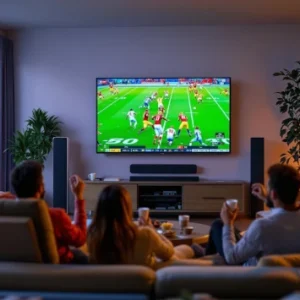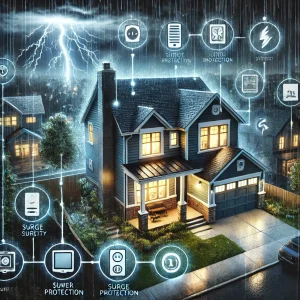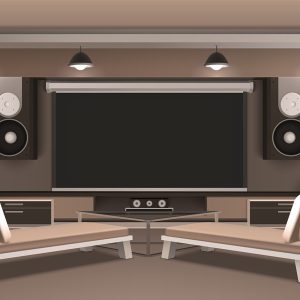Home Theater Lighting
Lighting is essential in home theaters, just like any home. It may set the tone for your home theater experience by generating a particular atmosphere and mood. The first thing you should do when setting up a home theater is ensure the lighting looks and feels professional. To make your home theater look great, select lighting ideas, get the appropriate fixtures, and arrange them properly. You’ll need a light fixture that can offer enough light without being overly bright or intrusive to the screen content. You may select the ideal home theater lighting fixture for your requirements from a wide selection available.
Ambrosic Home Theater Designs, LLC offers high-quality home theater installation services. Our simple yet stylish installations and imaginative advice have satisfied clients incredibly. Contact us today for all your home theater lighting needs!
Types of Home Theater Lighting
There are a few types of home theater lighting. Each kind of home theater lighting has a distinct purpose. Thus, it should be used appropriately. More significantly, how your home theater feels overall varies depending on the lighting you use. Here are the types of lighting and how each can be used in home theaters.
1. Ambient Lighting
Ambient home theater lighting is your house’s primary source of light that gives the room an overall glow. It furnishes your home theater with a cozy and tranquil ambiance and provides adequate lighting so guests can move comfortably without running into furniture or stumbling over wires. Ambient lighting is ideal for a comfortable and soothing home theater experience for your friends and family.
2. Task Lighting

Task home theater lighting is for certain activities, such as reading a book. It should be sufficiently bright to light up whatever job you are working on without being so bright as to cause glare or divert your attention from what is on screen. Task lighting for home theaters can originate from:
- Pendant lights or recessed spotlights with variable brightness and direction.
- Additionally, it can include integrated LED floor lighting placed close to places where people would sit down to watch TV or read a book.
Less is more when it comes to task lighting. A lot of light in your face or on the screen should not be glaring at you. Select a fixture that can be pointed toward the current work and modify it to suit your needs.
3. Accent Lighting
Accent lighting for home theaters draws attention to particular elements in the room, including furniture or artwork. It highlights the items you want people to view and establishes focus points in your home theater. Utilizing it as the room’s primary lighting source is never appropriate.
Accent home theater lighting may be added to your room in various ways. For example, you can use rope or LED strip lights to highlight furniture or artwork or to form a border around the screen. Accent lighting for home theaters is ideal for giving your space flair and individuality. It may be to draw attention to your most significant accomplishments or to give your area a distinctive style.
4. LED Lighting
LED lighting is a popular option for home theaters due to its energy efficiency and ability to produce bright, even light. You may select the ideal LED light to complement the decor of your home theater, as they are widely available in a range of hues. LED strip lights are flexible when it comes to home theater lighting, and they may be put in several ways to create an accent of light, like beneath cabinets, in the back of crown molding, and to create the illusion of a frame, placing them around a room’s edges.
LED lighting may light up and create a vibe in your movie room, no matter how it is set up.
5. Backlighting or Bias Lighting
Backlighting, also referred to as bias lighting, is a home theater lighting that enhances the viewing experience and lessens eye strain. Usually mounted behind the TV, it provides lighting to the wall or area behind it. Backlighting is a popular home theater lighting choice because it:
- Minimizes eye strain
- Enhances the pleasure of watching
- Is a cost-effective choice
- Is installable behind any television
Consider adding backlighting if you’re searching for a solution to enhance your home theater experience. One way to do this is by mounting rope or LED strip lights on the back of your television.
- Run the light strips around the room and up the wall to create a border effect.
- You are putting up a light bar over your television.
Select the illumination method that best suits your needs from the several available for your home theater.
6. Fiber Optic Lighting
This unusual home theater lamp uses thin fiber optic cable strands to convey light. This form of home theater lighting is quite popular because it produces a dramatic impact and can create multiple moods in a place. Fiber optic home theater lighting comes in two varieties:
- Star ceiling
Fiber optic cable is used in this home theater lighting system to provide a starry ceiling image.
- Color-changing home theater lights
Color-changing LEDs connected by fiber optic cable are in this home theater lighting system, which can be operated remotely or through a smartphone app.
Fiber optic lighting is the perfect choice for anyone seeking to create a striking and distinctive aesthetic in their home theater.
7. Neon/Cold Cathode Lighting
Lighting using neon or cold cathode technology is gorgeous. However, because the entire part needs to be replaced in the case of a failure, it is typically costly and challenging to maintain. When utilized in conjunction with an interface, these lights may be dimmed. Neon or cold cathode lighting is frequently utilized as backlights to draw attention to other diffusive aspects and as cove lights to give a dramatic flare to the space. Nevertheless, neon and cold cathode sources are replaced by LEDs.

Frequently Asked Questions
How can Lighting Control Systems Benefit a Home Theater Setup?
A critical factor in establishing the perfect movie setting is lighting. A dimly lit area creates the perfect atmosphere for a movie to begin and keeps glare from degrading the image quality. Even so, getting around the space when you need to use the restroom or take a food break might be challenging.
Is it Advisable to use Dimmable Lights in a Home Theater?
Yes, it’s advisable to use dimmable lights in a home theater. Adjusting brightness levels according to one’s tastes and the information watched is more accessible with dimmable lights. Ambient lighting is the ideal option to reduce distractions because the primary goal of a home theater is to create a committed viewing experience. Uneven illumination of a projected image can be caused by hanging or suspended fixtures and lamp lights reflecting onto the screen.
Are LED Lights a Good Choice for Home Theater Applications?
LED lights are a good choice for home theater applications. Because of their adaptability and energy economy, LED lights are widespread. Look for LEDs with a high color rendering index (CRI) for realistic color representation.

Home Theater Installation Services
The lighting in your home theater is just as crucial to the room as your chosen technology. It has a crucial role in setting the tone and defining the area. The lighting in a space, whether a media room or a dedicated home theater, significantly impacts how people feel when they walk in.
Are you ready to bring lighting to your Hilton Head Island home theater design project? Contact Ambrosic Home Theater Designs, LLC today to learn how smart home lighting solutions work perfectly in your home theater.




